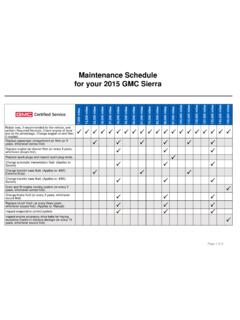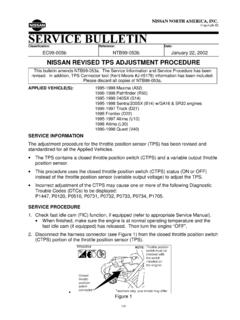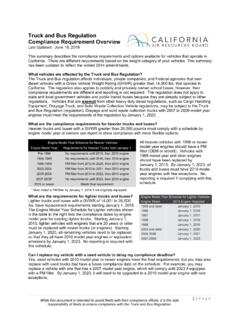Transcription of SI engine combustion - MIT
1 1SI engine combustion 1SI engine combustion :How to burn things?Reactants ProductsPremixed Homogeneous reaction Not limited by transport process Fast/slow reactions compared with other time scale of interest Premixed flame Examples: gas grill, SI engine combustion Detonation Pressure wave driven reactionNon-premixed Diffusion flame Examples: candle, diesel engine combustion22SI engine combustion Premixed flame Laminar flame speed Turbulent enhancement of combustion Wrinkled laminar flame3 LAMINAR FLAME SPEEDSFig. 9-25 Laminar burning velocity of several fuels as function of equivalence ratio, at 1 atm and 300 9-26 Effect of burned gas mole fraction in unburned mixture on laminar burning velocity. Fuel: gasoline.(Note that actual burned gas from non-stoichiometric combustion would render the charge different from the metered.)
2 4 For inert diluent3 Schematic of SI engine flame propagationFig. 9-4 Schematic of flame propagation in SI engine : unburned gas (U) to left of flame, burned gas to right. A denotes adiabatic burned-gas core, BL denotes thermal boundary layer in burned transferWork transfer5 Typical pressureand mass fraction burned (xb) curves02004006000510152025crank angle (deg)dxb/d xb *10PP(bar); xb*10; d(xb)/d (% per CA-deg)mass fraction burned xbSI engine ;1500 rpm, bar intake pressureUseful conversions:1000 rpm:6oCA/ms1200 rpm:20 Hz (For 4 stroke engine10 cycle/s100 ms/cycle)6401002003004005006007000102030 4050P (bar)01002003004005006007000100020003000 Temperature (K) Angle, degreecumulative flow (g)SI engine part-load rpm; MAP=38kPa; =1; ign @ (K) (%/deg) and fraction burnedBurned gasUnburned gasLaminar flame speedLaminar expansion velocityPressureMass burn rateVb/V2*R/BSI engine part-load operation85 combustion produced pressure riseFlameubub m mFlametime ttime t + is uniform, changing with mass m: hb= hu(because dm is allowed to expand against prevailing pressure) rise is a function of fuel heating value and mixture composition at = 1, Tu~ 700 K, Tb~ 2800 burned gas expands: b~ u; Vb~ 4 Vu9 combustion produced pressure total volume is constrained.
3 The pressure must rise by p, and all the gas in the cylinder is the unburned gas ahead of flame and burned gas behind the flame move away from the flame the unburned gas and burned gas temperatures rise due to the compression by the newly burned gas state: since heat transfer is relatively small, the temperature is related to pressure by isentropic relationship Tu/Tu,0= (p/p0)( u-1)/ gas state: uFlameEarly burned gas, higher TbLater burned gas, lower Tb106 Thermodynamic state of chargeFig. 9-5 Cylinder pressure, mass fraction burned, and gas temperatures as function of crank angle during combustion . 11 Burn duration Burn duration as CA-deg. : measure of burn progress in cycle For modern fast-burn engines under medium speed, part load condition: 0-10%~ 15o 0-50%~ 25o 0-90%~ 35o As engine speed increases,burn duration as CA-deg.
4 : Increases because there is less time per CA-deg. Decreases because combustion is faster due to higher turbulence Net effect: increases approximately as combustion Phasing Heat release schedule has to phase correctly with piston motion for optimal work extraction In SI engines, combustion phasing controlled by spark Spark too late heat release occurs far into expansion and work cannot be fully extracted Spark too early Effectively lowers compression ratio increased heat transfer losses Also likely to cause knock Optimal: Maximum Brake Torque (MBT) timing MBT spark timing depends on speed, load, EGR, , temperature, charge motion, .. Torque curve relatively flat: roughly 5 to 7oCA retard from MBT results in 1% loss in torqueSpark timing effectsFig. 9-3 (a) Cylinder pressure versus crank angle for overadvanced spark timing (50oBTDC), MBT timing (30oBTDC), and retarded timing (10oBTDC).
5 (b) Effect of spark advance on brake torque at constant speed and A/F, at WOT8 control of spark timingWOTFig. 15-3 Fig. 15-17 Borderline knock spk advObtaining combustion information from engine cylinder pressure pressure affected by:a)Cylinder volume changeb)Fuel chemical energy release by combustionc)Heat transfer to chamber wallsd)Crevice effectse)Gas accurate combustion rate information requiresa)Accurate pressure data (and crank angle indexing)b)Models for phenomena a,c,d,e, abovec)Model for thermodynamic properties of cylinder methodsa)Empirical methods ( Rassweiler and Withrow SAE 800131)b)Single-zone heat release or burn-rate modelc)Two-zone (burned/unburned) combustion model9 Typical piezoelectric pressure transducer of NIMEP to crank angle phase errorSI engine ;1500 rpm, bar intake pressure-15-10-5051015-3-2-10123 Crank angle phase error (deg)Percent error in NIMEP10 Cylinder pressureFig.
6 9-10 (a) Pressure-volume diagram; (b) log p-log(V/Vmax) plot; 1500 rpm, MBT timing, IMEP = bar, = , rc= , propane mass analysis Rassweiler and Winthrow(SAE 800131)Fraction of maximum volumePressure, kPappfp0 IgnitionEnd of combustion |slope|=n 0fub1/ nu,0u1/ nb,fbu,0b,fb0fDuring combustion V = VVUnburned gas volume, back trackedto spark (0)VV(p/p)Burned gas volume, forward trackedto end of combustion (f)VV(p/p)Mass fraction bunredVVx1VV 1/ n1/ n00b1/ n1/ nff00 Hence, after some algebrapVp VxpVp V Advantage: simple Need only p( ), p0, pfand n xbalways between 0 and 120(There are two procedures described in the paper; this is one of them)11 Heat release analysisFig. 9-11 Open system boundary for heat-release analysisEnergy balance:dQch/dt= dUs/dtSensible energy change+ pdV/dtWork transfer+ dQht/dtHeat loss to walls+ h dmcr/dtFlow into crevice-hinjdmf/dtInjected enthalpyFuel chemical energy release211 zone modelNet heat releasedResults of heat-release analysisFig.
7 9-12 Results of heat-release analysis showing the combustion inefficiency and the corrections due to heat transfer and crevice and combustion ProcessinSpark-Ignition EngineA Color Schieren Movietaken in a Special Visualization Engine23 Square piston engine Visualization by color-schlieren method Captures density gradients Note: Flame propagation process Outgasing from crevicesSquare piston flow visualization mmCompression conditionSpeed1400 rpm barSpark timingMBT2413 Flame Propagation (Fig 9-14)1400 bar inlet pressur
















